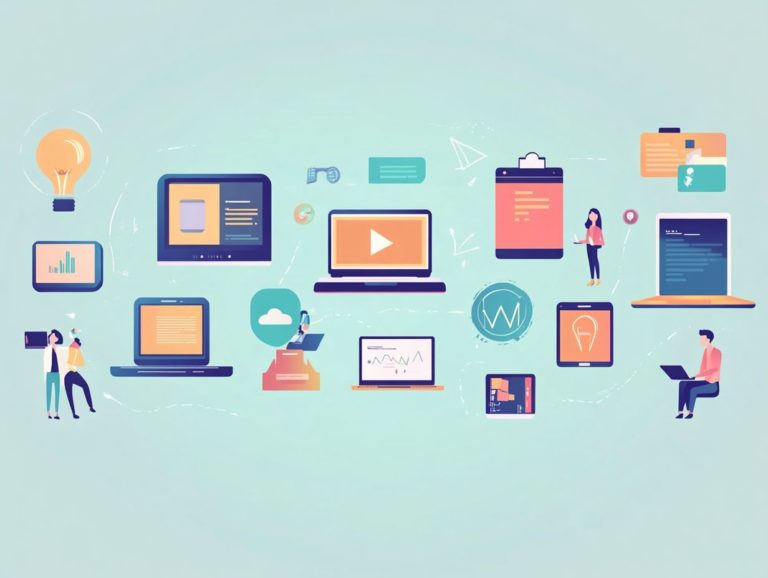5 Benefits of Using E-Learning for Training
In today s fast-paced world, e-learning has emerged as a vital tool for training and development. Discover how e-learning can revolutionize training for both employers and employees!
Its flexibility, cost-effectiveness, and personalized learning experiences cater seamlessly to diverse learning needs. This article delves into five key benefits of e-learning, ranging from effortless access to resources to enhanced retention and engagement. You’ll also uncover how e-learning operates, the various formats it encompasses, and the potential challenges organizations may encounter along with effective strategies to navigate those obstacles.
Contents
- Key Takeaways:
- 1. Flexibility in Learning
- 2. Cost-Effective
- 3. Personalized Learning Experience
- 4. Discover the World with Easy Access to Resources!
- 5. Improved Retention and Engagement
- How Does E-Learning Work?
- Frequently Asked Questions
- What are the top 5 benefits of using e-learning for training?
- How does e-learning promote a more engaging training experience?
- Can e-learning save time for both learners and trainers?
- What are some disadvantages of using e-learning for training?
- How can e-learning benefit companies with remote employees?
- What is the role of e-learning in employee development and retention?
Key Takeaways:

- Flexibility in learning allows employees to learn at their own pace, making it easier to balance work and training.
- E-learning saves money on travel, materials, and instructor fees.
- Personalized learning experiences tailor training to individual needs and learning styles, increasing engagement and retention.
1. Flexibility in Learning
Flexibility in learning stands out as a compelling advantage of e-learning. It allows you to customize your educational experience to fit your schedule, preferences, and learning styles.
This adaptability is essential, especially when traditional classrooms often fall short of meeting the needs of modern learners. With online education, you have the freedom to engage in learning at your own speed, harness advanced technologies, and access resources from virtually anywhere, all of which elevate your educational journey.
Platforms like Coursera and EdX are perfect examples of this trend, giving you the power to select course timings that align with your lifestyle, whether you’re juggling work, family commitments, or other responsibilities.
The emergence of digital devices such as smartphones, tablets, and laptops has transformed the learning landscape. You can study during commutes or while traveling. Self-paced learning accommodates diverse styles; visual learners can thrive with video lectures, while auditory learners can dive into podcasts and interactive discussions.
This rich array of resources makes the e-learning experience not only accessible but also wonderfully inclusive.
2. Cost-Effective
One of the major financial advantages of e-learning is its remarkable cost-effectiveness. It makes education far more accessible than traditional methods, which often come with steep tuition fees and additional costs.
Online education platforms, like MOOCs (Massive Open Online Courses) on Coursera and EdX, offer high-quality courses at significantly lower prices. This allows you to save on expenses related to physical classrooms and travel.
Many of these platforms provide courses for free or at a fraction of the cost of conventional college courses, which can easily exceed thousands of dollars per semester. Platforms such as LinkedIn Learning even offer subscriptions for unlimited access to a vast library of training materials.
This makes them a budget-conscious choice for both individuals eager to expand their skill sets and employers investing in workforce development. By eliminating commuting and accommodation expenses, e-learning lightens the immediate financial load for students.
It also ensures long-term savings, enabling both learners and organizations to channel more resources into their future growth and innovation. Don t miss out on the opportunity to enhance your skills today!
3. Personalized Learning Experience
The concept of personalized learning in eLearning is truly transformative! It offers you the opportunity to shape your educational experience through adaptive learning technologies tools that adjust to your learning pace. This approach significantly boosts your engagement and satisfaction.
With the seamless integration of multimedia materials and tailored support, educational technology creates a space where you can prioritize your unique needs and preferences.
By harnessing data analytics, educators can customize course content to reflect your progress and performance, pinpointing the areas that need extra attention or present a challenge. Engaging strategies like gamification and collaborative projects are essential! They not only amplify your motivation but also foster a sense of community among fellow learners.
These personalized methods don t just deepen your connection to the material; they also enhance effective learning outcomes. Ultimately, this ensures that your individual journey is both fulfilling and impactful.
4. Discover the World with Easy Access to Resources!

Easy access to resources is the bedrock of eLearning, allowing you to harness digital devices and tap into a wealth of information from anywhere in the world through online learning platforms. This level of accessibility fosters vibrant knowledge exchange among peers and elevates your overall educational experience, especially in virtual classrooms where collaboration and insight-sharing happen effortlessly.
The range of resources at your fingertips in eLearning is impressive! You can explore:
- Interactive videos
- Podcasts
- Quizzes
- Multimedia presentations
These resources cater to various learning styles, such as auditory, visual, and kinesthetic. For instance, if you’re a visual learner, you can thrive on rich infographics and chart-based content, while auditory learners might gravitate toward engaging lectures or discussions.
Collaboration tools like discussion forums, video conferencing, and shared documents are essential for facilitating these interactions. They enable you to share your perspectives and build upon each other’s knowledge, enriching your understanding and fostering a sense of community within the digital learning environment.
5. Improved Retention and Engagement
Improved retention and learner engagement are significant advantages of eLearning for you! Immersive simulations and interactive content can yield effective learning outcomes that often surpass traditional methods. By harnessing technology and innovative teaching strategies, eLearning environments create opportunities for continuous learning, giving you the power to retain knowledge more effectively.
Gamification techniques like earning badges or climbing leaderboards inject a fun, competitive element into your educational experience, making learning an engaging adventure! Similarly, immersive simulations, such as those employed in medical training, allow you to practice complex procedures in realistic virtual settings, significantly enhancing your understanding and memory retention.
These methods not only capture your attention but also promote active participation, enabling you to bridge the gap between theoretical knowledge and practical application. This makes eLearning a dynamic and adaptable alternative to conventional classrooms, tailored to fit your learning journey.
Start your personalized learning journey today and unlock your potential!
How Does E-Learning Work?
E-learning operates by harnessing digital platforms to deliver educational content. This allows you to engage in online education and distance learning with remarkable efficiency.
By combining multimedia materials, interactive modules, and assessment tools, e-learning creates a vibrant learning environment tailored to diverse learners. This significantly enhances your educational experience.
This innovative approach includes video lectures, quizzes, and discussion forums, giving you the power to absorb information at your own pace while fostering collaboration with peers. The online learning platforms don t just track your progress and performance; they also provide analytics that enable educators to refine their teaching strategies effectively.
By integrating various content types like simulations and game-like elements e-learning caters to different learning styles, making education more accessible and personalized. These components work in harmony to create a captivating learning journey tailored just for you.
What Are the Different Types of E-Learning?
You ll find a variety of eLearning options, each designed to cater to your unique learning needs. Whether it s distance learning, MOOCs, or collaborative learning environments, these digital formats offer flexibility and personalization.
Take distance learning, for example. It provides an asynchronous format that lets you progress at your own pace perfect for juggling work and studies without feeling overwhelmed.
Then there are MOOCs, or Massive Open Online Courses, which cover a vast array of topics for self-motivated learners like you. They enable access to knowledge without the constraints of traditional education.
Collaborative learning environments stimulate interaction with peers and instructors, creating a dynamic atmosphere for engagement and mutual exploration. Platforms such as Coursera, Udacity, and EdX are instrumental in this landscape, offering a rich variety of content tailored to these formats, ensuring you can easily find what you need to excel in your educational journey.
What Are the Key Features of an Effective E-Learning Program?

An effective eLearning program is built upon several key features that elevate training effectiveness. You’ll find that strong engagement methods, learner feedback mechanisms, and the ability to track learning metrics are essential components.
For compliance training, it’s crucial that these programs meet specific standards to ensure you acquire the knowledge and skills you need.
These vital elements work together to create an immersive learning experience that not only captivates you but also fosters long-term knowledge retention. For instance, incorporating interactive elements like quizzes and using game-like features can significantly boost your motivation, while timely feedback helps you address any misunderstandings quickly.
Integrating learner analytics allows program designers to tailor content to suit your diverse needs, enhancing overall effectiveness. A prime example is the use of adaptive learning paths found in platforms like Coursera and LinkedIn Learning, which adjust the curriculum based on your individual progress and performance, ensuring compliance while keeping you engaged.
How Can E-Learning Benefit Employers and Employees?
E-Learning presents a wealth of advantages for both employers and employees, offering cost-effective training solutions that foster skill development and career advancement. Exploring successful e-learning implementation can boost learner satisfaction and ensure your team is ready for today’s challenges!
This dynamic approach gives you the power to take charge of your professional growth. It aligns seamlessly with organizational objectives, driving overall performance.
In such an environment, employees feel valued and motivated to embark on their development journeys. This results in increased retention rates.
The flexibility of eLearning caters to diverse learning styles, allowing you to engage with content on your own terms. Consequently, organizations cultivate a culture of continuous learning, promoting innovation and adaptability qualities that are critical for navigating today s fast-paced business landscape.
What Are the Challenges of Implementing E-Learning in an Organization?
Implementing eLearning within your organization can bring a range of challenges. These include ensuring the effectiveness of training, keeping learners engaged, and maximizing your online training platforms.
Navigating these obstacles is crucial for the successful adoption of eLearning initiatives, as overlooking them can lead to significant pitfalls.
For example, if your training materials don’t align with the specific roles or objectives of the learners, retention rates are likely to plummet. Additionally, overly complex or unfriendly platforms can lead to employee frustration, resulting in decreased participation.
You may also encounter varying levels of technological literacy among your workforce, affecting their ability to engage fully with the content. If these issues remain unaddressed, they can seriously undermine the intended benefits of eLearning. This situation may leave your workforce without the essential skills and knowledge needed to excel in a competitive landscape.
How Can Organizations Overcome These Challenges?
You can effectively navigate the challenges of eLearning implementation by employing targeted strategies that enhance learner engagement and ensure successful training outcomes. By leveraging teamwork tools and providing ongoing support, you can create a thriving eLearning environment that meets the diverse needs of all learners.
One effective approach is to use interactive content, like quizzes and simulations, which can spark interest and reinforce learning. Integrating a learning management system (LMS) enables you to track progress and provide tailored feedback based on individual performance.
Fostering a community of practice encourages peer interaction and support, leading to a more enriching training experience. Investing in high-quality multimedia resources can further captivate learners, keeping them engaged and motivated throughout their training journey.
Frequently Asked Questions

What are the top 5 benefits of using e-learning for training?
1. Flexibility and convenience: E-learning allows training anytime, anywhere, making it incredibly convenient for learners and providing creative ways to use e-learning in training.
2. Cost-effective: With e-learning, there is no need for physical materials or trainers, resulting in lower costs for training, as highlighted in the benefits of on-demand e-learning for employees.
3. Customized learning experience: E-learning can be tailored to fit individual learning styles and needs, resulting in a more effective and engaging training experience. To explore more, check out the benefits of online corporate training.
4. Accessibility: E-learning eliminates geographical barriers, making training accessible for learners all over the world, highlighting the key elements of effective e-learning.
5. Continuous learning: E-learning lets learners dive back into materials anytime, promoting ongoing growth with essential features of effective e-learning tools!
How does e-learning promote a more engaging training experience?
E-learning often incorporates interactive elements such as videos, quizzes, and games, making the training experience more engaging and enjoyable for learners.
Can e-learning save time for both learners and trainers?
Yes, e-learning saves time for both learners and trainers. Learners complete training at their own pace.
Trainers can focus on developing and updating content instead of delivering in-person sessions.
What are some disadvantages of using e-learning for training?
Some learners may struggle with self-motivation. They may need extra support to complete their training successfully.
Technical issues and unreliable internet can also impact e-learning effectiveness.
How can e-learning benefit companies with remote employees?
E-learning is a game-changer for training remote employees! It eliminates travel needs and allows training from any location, especially when using tips for engaging employees in e-learning.
It also ensures all employees receive consistent training, no matter where they are.
What is the role of e-learning in employee development and retention?
E-learning promotes continuous learning and development. This leads to greater job satisfaction and higher employee retention rates.
Employees gain new skills and knowledge, paving the way for career advancement within the company.






